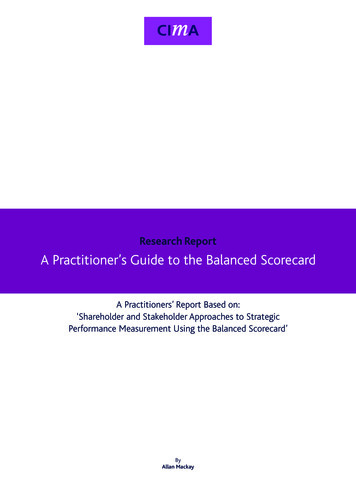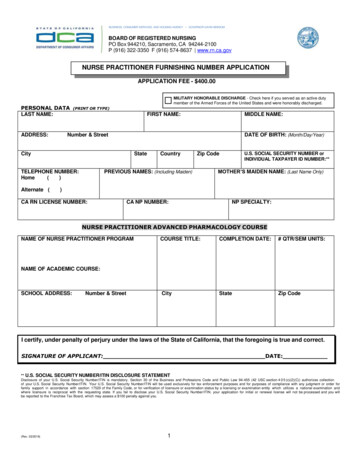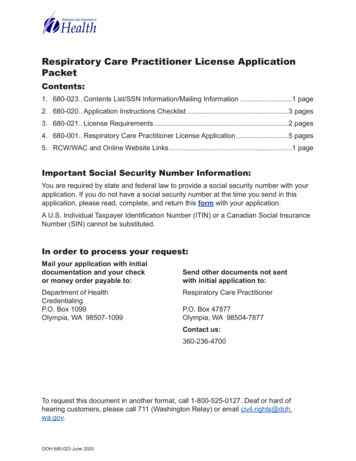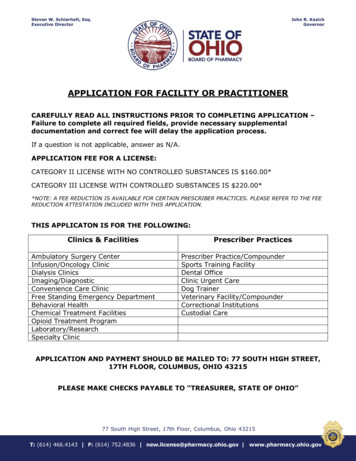
Transcription
A PRACTITIONER’S GUIDE TOBASEL III AND BEYONDConsultant EditorRichard BarfieldPricewaterhouseCoopers LLP
3559 00 FM.qxp6/9/117:28 PMPage xixContentsBiographiesAuthor email and phone detailsForewordPreface1IntroductionRichard verviewFor whom is the Guide intendedOverview of the reform agendaThe playersA brief history of BaselBasel III in a nutshellCoverage of the GuideLooking forwardConclusion112489131819Strategic ContextRichard Kibble and James Worsnip212.12.22.32.42.52123354752IntroductionThe reforms in contextBasel III – Impact and responseUnintended consequencesConclusionDefining CapitalChris iew of the key changesDefinition of capital under Basel I and Basel IIGoing concern v gone concernThe definition of capital under Basel 01243
3559 00 FM.qxp6/9/117:28 PMPage xxA Practitioner’s Guide to Basel III and 7IntroductionThe Standardised Approach to marketrisk capitalThe internal model approach to marketrisk capitalThe Basel II review of the trading bookin 2005The effect of the crisisBasel II.5 and Basel III changesMarket risk – looking forward9092939497116Counterparty Credit RiskMonika Mars and Agatha Pontiki1215.15.25.31211215.46788081828586Trading Book and SecuritisationIna de Vry4.35New minimum capital ratiosContingent capitalThe capital buffersPractical onOverview of counterparty credit riskProposals to enhance counterparty creditrisk captureImplications and practicalities126141Liquidity and FundingCharlie Beach and Claire Rieger1476.16.26.3147153169IntroductionBasel III regulationsImplications and practical issuesLeverageFernando de la Mora1817.17.2181182IntroductionBackgroundxx
3559 00 FM.qxp6/9/117:28 PMPage 39.49.5219220223227IntroductionThe role of Pillar 2 under Basel IIImpact of Basel III on Pillar 2Implications for economic capitalImportance of risk management –strengthening the SREPConclusion231233ProcyclicalityMonika tion of Basel III with current andproposed accounting guidancePractical implementation considerationsConclusionRole of Pillar 2Chris Matten9.610187192Accounting ConsiderationsSimon Gealy and Addison Everett8.38.49Basel responseConclusionIntroductionManaging procyclicalityBasel III proposals to addressprocyclicalityConclusion240256Stress TestingFernando de la Mora, Richard Barfield andPramit sel III guidelinesKey features off effective stress 8930123456789401243
3559 00 FM.qxp6/9/117:28 PMPage xxiiA Practitioner’s Guide to Basel III and 041x243121314Disclosures and Pillar 3Christophe ew Barling and Anne-Marie he taxation environment for banksTax implications of Basel III proposalsConclusionRewardTom oductionOverview of risk disclosure requirementsPractical implementation challengesConclusion – the future of riskmanagement disclosuresIntroductionForces for changeIncorporating risk into performancemeasuresDesign of compensationGovernance of remunerationDisclosure of remunerationConclusion337348356362364Recovery and Resolution PlanningDuncan McNab36715.115.215.336736915.415.515.6Introduction – in peace plan for warInternational overviewRecovery – financial Business ContinuityPlanningResolution – planning for your own funeralReality check – lessons learned from the pilotsConclusionxxii374379383384
3559 00 FM.qxp6/9/117:28 PMPage xxiiiContents161718Stakeholder PerspectivesRichard 387389393396399402404407Implications for Risk ManagementSonja du 34IntroductionEstablishing an explicit risk cultureRole of the boardRisk appetiteChief risk officerConclusionImplications for the EconomyNick nThe funding spectrumEquity investorsDebt investors and contingent capitalDepositors and borrowersGovernment and the taxpayerRating agenciesTransparency for stakeholdersConclusionIntroductionHow banks (and banking regulations)impact the economyLikely response of banksImpact of previous regulatory changesImpact on the broader economyConclusion441450452454466Implications for SupervisionPatrick Fell46919.119.219.319.4469471475476IntroductionThe core principlesRethinking supervisionNew style supervision – the glide 89401243
3559 00 FM.qxp6/9/117:28 PMPage xxivA Practitioner’s Guide to Basel III and 041x24319.519.619.719.819.9Key principles for macro-prudentialsupervisionWill the authorities be able to meet theexpectations placed on them?The place of the regulatorInternational oversightConclusion479482492494498Appendix I – Trends in Pillar 3 reporting and riskdisclosures501Appendix II – List of banks covered in the analysisof Pillar 3 and risk managementdisclosures511Appendix III – CEBS observed good practices fordisclosures on activities affected bythe market turmoil (with mapping tothe SSG leading practices)513Index519xxiv
3559 01 CH01.qxp6/4/115:21 PMPage 1Chapter 1IntroductionRichard Barfield1.1 OverviewBasel III represents the biggest regulatory change that thebanking industry has seen in decades. It is salutary to rememberthat it is only one, albeit very important, component of a suite ofrelated reforms that are changing banking, regulation, supervision and the relationship between banks and the state.In November 2010 the G20 ratified the Basel Committee’sproposals for strengthening capital and liquidity standards. Indoing so, they committed the global banking industry to significant change and a transition period that extends beyond 2020.Distant deadlines have the danger of creating complacency andinaction. Leading banks recognise this threat and have no desireto suffer the same fate as the apocryphal simmering frog. Themarket is also asking how banks will be impacted. The questionthen, is what practical actions should banks be taking? ThisGuide aims to provide some answers.To set the scene, this Chapter introduces Basel III, the reformlandscape, the key players, and provides an overview ofthe Guide.1.2 For whom is the Guide intended?This is a Practitioner’s Guide to the potential implications ofBasel III and beyond: we go beyond the text of the new Baselguidance to consider implications and practical implementationissues. The Guide also goes beyond Basel III to consider 9401243
3559 01 CH01.qxp6/4/115:21 PMPage 2A Practitioner’s Guide to Basel III and 041x243related reforms such as changes to recovery and resolution(what banks should do when they are at risk of failing or whenthey have failed). This is therefore a Practitioner’s Guide thataims to address the new realities.The Guide is intended to have broad appeal; the types of readerthat we had in mind when putting finger to keyboard includedfor example:(a) CEOs and directors wanting to understand the importantparts of the G20 reform agenda and its consequences forfinancial institutions;(b) CFOs, CROs, Compliance Officers, Treasurers, and COOsgrappling with managing one of the most complex changeagendas in history; and(c) supervisors and legal advisers looking for a rounded andcoherent overview of Basel III and insights into what itmight mean for banks.1.3 Overview of the reform agendaIt is important to put Basel III in context. The G20’s main aimon banking reform is to ensure that governments never againhave to bail out the sector. They want to remove the implicitguarantee that governments will back large banks if they get intotrouble. The G20 does not want to eradicate bank failure nor doesit expect central banks never to have to provide liquidity supportto troubled firms, but the G20 is absolutely clear that bankdependency on taxpayer support on the scale witnessed over thelast three years is unacceptable and must not be repeated.The clarity and unity of purpose of the G20 on the issue is unparalleled. Recent events in Ireland, Greece and Portugal illustratethe importance of achieving this goal. However, for it to happen,that unity of purpose will need to be sustained for a long time.The causes of the global financial crisis were complex and,because of the interconnectedness of the financial system, itsimpact was felt far and wide. However, it did not affect all banksor all economies in the same way. Several countries’ banksemerged unscathed. Asia generally, Australia, Brazil, Russia,2
3559 01 CH01.qxp6/4/115:21 PMPage 3IntroductionCanada and South Africa are some notable examples. This is whythe G20’s unity is remarkable, but unity it has been nonetheless.Given that the Financial Stability Forum (“FSF”) was born at theG7 Finance Ministers’ meeting in the wake of the Asian financialcrisis of 1999, perhaps we should not be so surprised. Since then,the G7 grouping has grown in both number and scope. Inresponse to the 2007 financial crisis, G20 summits involvingheads of state were convened. The summits were preceded bymeetings of the G20 Finance Ministers and Central BankGovernors. The G20 was designated the premier forum for international economic cooperation at the Pittsburgh G20 summit in2009, formally superseding the G7. In the same year, theFinancial Stability Board (“FSB”) superseded the FSF.Since the crisis, a plethora of reforms have been proposed froma wide variety of sources, not just the Basel Committee. Theseincluded the FSB’s proposals on reward; the EuropeanCommission’s proposals on governance in financial institutions; bank levies proposed globally and locally; and taxes onbankers’ bonuses etc. Figure 1.1 gives an idea of the range andcomplexity of reform that is being pursued. The Basel proposalsare one item on this list.Figure 1.1 The reform agendaThe reform agendaBasel II.5 and Basel IIIProduct market regulationPre–funding of deposit insurancePro-consumer regulationResolution fundRole of credit rating agenciesWholesale levySecuritisation marketsProvisions and other accountingchangesFund managers to improve fundliquiditySubsidiarisationHedge fund regulationCentral counterparty clearing(OTC contracts)Bank risk management and governanceReporting (capital and unerationSupervisory approachNarrow bankingCross–border colleges“Glass–Steagall II”Recovery and 6789401243
3559 01 CH01.qxp6/4/115:21 PMPage 4A Practitioner’s Guide to Basel III and 041x243To give one example of the scale of other reforms: in the US, theDodd-Frank Act was signed into law on 21 July 2010 and has2,319 pages (by contrast the 1933 Glass-Steagall Act had a mere37 pages). The remarkable thing is that the Dodd-Frank Act isjust the beginning. Ten US regulatory agencies are now puttingthe detailed regulatory flesh on the bare legislative bones.As the devils lie in the detail, the final consequences ofDodd-Frank may be unclear for years to come. And, of course,Dodd-Frank does not cover everything in Figure 1.1.The scope of reforms addressed in other countries may, in somecases, be similar in breadth to the reforms brought about byDodd-Frank, but these will vary according to local context,history, experience of the crisis, existing central bank and regulatory frameworks etc.The impact of Basel III in each country will also need to be placedin the context of the local reform agenda. For example, in theEuropean Union, Solvency II (which sets out strengthened riskmanagement and capital adequacy requirements for insurancefirms) is being introduced with a proposed “go-live” date of1 January 2013. This parallel development may have impacts onbanks, for example in the availability and pricing of mediumterm funding.There are also much bigger forces at play. There is the rebalancing of the world economic order to the East and the South,large government deficits in several Organisation for EconomicCooperation and Development (“OECD”) economies,persistent trade imbalances and mis-valued currencies. Thismeans that reforms are being introduced in “interesting times”.1.4 The playersSo, who are the main players in shaping the reform agenda?The G20 sponsors the FSB whose central goals are to improvethe functioning of financial markets and to maintain financialstability through coordinating the work of national financialbodies and promoting effective regulatory, supervisory andother financial sector policies.4
3559 01 CH01.qxp6/4/115:21 PMPage 5IntroductionThe Basel Committee on Banking Supervision (the “Committee”or “BCBS”) is one of the 42 FSB members and the centralforum for regular cooperation on banking supervisory matters.It takes its name from the Swiss border town where its secretariat is based. This is also where Committee members, seniorofficials responsible for banking supervision or financialstability issues, meet. The members come from central banksand other authorities with formal responsibility for the prudential supervision of banking. Over recent years, it has developedincreasingly into a standard-setting body on all aspects ofbanking supervision. At the time of writing (March 2011), theChairman of the Committee is Mr Nout Wellink, President ofthe Netherlands Bank.The countries represented on the Basel Committee are:Argentina, Australia, Belgium, Brazil, Canada, China, Fra
7.3 Basel response 187 7.4 Conclusion 192 8 Accounting Considerations 197 Simon Gealy and Addison Everett 8.1 Introduction 197 8.2 Interaction of Basel III with current and











